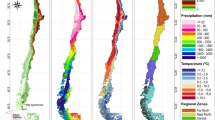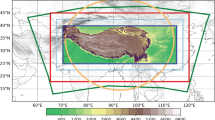Abstract
Cutoff lows are an important source of rainfall in the mid-latitudes that climate models need to simulate accurately to give confidence in climate projections for rainfall. Coarse-scale general circulation models used for climate studies show some notable biases and deficiencies in the simulation of cutoff lows in the Australian region and important aspects of the broader circulation such as atmospheric blocking and the split jet structure observed over Australia. The regional climate model conformal cubic atmospheric model or CCAM gives an improvement in some aspects of the simulation of cutoffs in the Australian region, including a reduction in the underestimate of the frequency of cutoff days by more than 15 % compared to a typical GCM. This improvement is due at least in part to substantially higher resolution. However, biases in the simulation of the broader circulation, blocking and the split jet structure are still present. In particular, a northward bias in the central latitude of cutoff lows creates a substantial underestimate of the associated rainfall over Tasmania in April to October. Also, the regional climate model produces a significant north–south distortion of the vertical profile of cutoff lows, with the largest distortion occurring in the cooler months that was not apparent in GCM simulations. The remaining biases and presence of new biases demonstrates that increased horizontal resolution is not the only requirement in the reliable simulation of cutoff lows in climate models. Notwithstanding the biases in their simulation, the regional climate model projections show some responses to climate warming that are noteworthy. The projections indicate a marked closing of the split jet in winter. This change is associated with changes to atmospheric blocking in the Tasman Sea, which decreases in June to November (by up to 7.9 m s−1), and increases in December to May. The projections also show a reduction in the number of annual cutoff days by 67 % over the century, together with an increase in their intensity, and these changes are strongest in spring and summer.











Similar content being viewed by others
References
Bals-Elsholz TM, Atallah EH, Bosart LF, Wasula TA, Cempa MJ, Lupo AR (2001) The wintertime Southern Hemisphere split jet: structure, variability and evolution. J Clim 14:4191–4215
Bengtsson L, Botzet M, Esch M (1995) Hurricane-type vortices in a general circulation model. Tellus 47A:175–196
Brown JN, McIntosh PC, Pook MJ, Risbey JS (2009) An investigation of the links between ENSO flavors and rainfall processes in Southeastern Australia. Mon Weather Rev 137:3786–3795
Corney SP, Katzfey JK, McGregor JL, Grose MR, Bennett J, White CJ, Holz G, Gaynor S, Bindoff NL (2010) Climate futures for Tasmania: climate modelling. Antarctic Climate and Ecosystems Cooperative Research Centre, Hobart
ECMWF (2010) European Centre for Medium-range Weather Forecasts. Re-analysis data [Internet]. British Atmospheric Data Centre. Accessed 2010
Hines KM, Bromwich DH, Marshall GJ (2000) Artificial surface pressure trends in the NCEP–NCAR reanalysis over the Southern Ocean and Antarctica. J Clim 13:3940–3952
Jones DA, Wang W, Fawcett R (2009) High-quality spatial climate data-sets for Australia. Aust Meteorol Oceanogr J 58:233–248
Kalnay E, Kanamitsu M, Kistler R, Collins W, Deaven D, Gandin L, Iredell M, Saha S, White G, Woollen J, Zhu Y, Leetmaa A, Reynolds R, Chelliah M, Ebisuzaki W, Higgins W, Janowiak J, Mo KC, Ropelewski C, Wang J, Jenne R, Joseph D (1996) The NCEP/NCAR 40-year reanalysis project. Bull Am Meteorol Soc 77:437–471
Katzfey JJ, McInnes KL (1996) GCM simulations of eastern Australian cutoff lows. J Clim 9:2337–2355
Kentarchos AS, Roelofs GJ, Lelieveld J (2000) Simulation of extratropical synoptic-scale stratosphere-troposphere exchange using a coupled chemistry GCM: sensitivity to horizontal resolution. J Atmos Sci 57:2824–2838
Kistler R, Kalnay E, Collins W, Saha S, White G, Woollen J, Chelliah M, Ebisuzaki W, Kanamitsu M, Kousky V, van den Dool H, Jenne R, Fiorino M (2001) The NCEP-NCAR 50-year reanalysis: monthly means CD-ROM and documentation. Bull Am Meteorol Soc 82:247–267
Kushner PJ, Held IM, Delworth TL (2001) Southern hemisphere atmospheric circulation response to global warming. J Clim 14:2238–2249
Lambert SJ (1988) A cyclone climatology of the Canadian Climate Centre general circulation model. J Clim 1:109–115
Leslie LM, Holland GJ, Lynch AH (1987) Australian east-coast cyclones, Part II: numerical modelling study. Mon Weather Rev 115:3037–3053
Matsueda M, Mizuta R, Kusunoki S (2009) Future change in wintertime atmospheric blocking simulated using a 20-km mesh atmospheric global circulation model. J Geophys Res 114:D12114. doi:12110.11029/12009JD011919
McGregor JL (2005) C-CAM: geometric aspects and dynamical formulation. CSIRO atmospheric research technical paper no. 70, p 43
McGregor JL, Dix MR (2008) An updated description of the conformal-cubic atmospheric model. In: Hamilton K, Ohfuchi W (eds) High resolution simulation of the atmosphere and ocean. Springer, Berlin, pp 51–76
McInnes KL, Leslie LM, McBride JL (1992) Numerical simulation of cutoff lows on the Australian east coast—sensitivity to sea surface temperature. Int J Climatol 12:783–795
McIntosh PC, Pook MJ, Risbey JS, Lisson SN, Rebbeck M (2007) Seasonal climate forecasts for agriculture: towards better understanding and value. Field Crop Res 104:130–138
McIntosh P, Pook M, Risbey J, Hope P, Wang G, Alves OA (2008) Final report—Australia’s regional climate drivers. Centre for Australian Weather and Climate Research, Hobart
Meehl GA, Stocker TF, Collins WD, Friedlingstein P, Gaye AT, Gregory JM, Kitoh A, Knutti R, Murphy JM, Noda A, Raper SCB, Watterson IG, Weaver AJ, Zhao Z-C (2007a) Global climate projections. In: Solomon S, Qin D, Manning M, Chen Z, Marquis M, Avery KB, Tignor M, Miller HL (eds) Climate change 2007: the physical science basis. Contribution of working group I to the fourth assessment report of the intergovernmental panel on climate change. Cambridge University Press, Cambridge
Meehl GA, Covey AC, Delworth T, Latif M, McAvaney B, Mitchell JFB, Stouffer RJ, Taylor KE (2007b) The WCRP CMIP3 multi-model dataset: a new era in climate change research. Bull Am Meteorol Soc 88:1383–1394
Nakićenović N, Swart R (2000) Special report on emissions scenarios. A special report of working group III of the intergovernmental panel on climate change. Cambridge University Press, Cambridge
Ndarana T, Waugh DW (2010) The link between cut-off lows and Rossby wave breaking in the Southern hemisphere. Q J Roy Meteorol Soc 136:869–885
Pook MJ, Gibson TT (1999) Atmospheric blocking and storm tracks during SOP-1 of the FROST project. Aust Meteorol Mag 48:51–60
Pook MJ, McIntosh PC, Meyers GA (2006) The synoptic decomposition of cool-season rainfall in the Southeastern Australian cropping region. J Appl Meteorol Climatol 45:1156–1170
Pook M, Lisson S, Risbey J, Ummenhofer CC, McIntosh P, Rebbeck M (2009) The autumn break for cropping in southeast Australia: trends, synoptic influences and impacts on wheat yield. Int J Climatol 29:2012–2026
Pook MJ, Risbey J, McIntosh P (2010) East coast lows, atmospheric blocking and rainfall: a Tasmanian perspective. IOP Conf Ser Earth Environ Sci 11:012011
Qi L, Leslie LM (2001) Cut-off low pressure systems over southern Australia: a numerical modelling study and sensitivity experiments. Aust Meteorol Mag 50:183–194
Qi L, Wang Y, Leslie LM (2000) Numerical simulation of a cut-off low over southern Australia. Meteorol Atmos Phys 74:103–115
Randall DA, Wood R, Bony S, Colman R, Fichefet T, Fyfe J, Kattsov VM, Pitman AJ, Shukla J, Srinivasan J, Stouffer RJ, Sumi A, Taylor KE (2007) Climate models and their evaluation. In: Solomon S, Qin D, Manning M, Chen Z, Marquis M, Avery KB, Tignor M, Miller HL (eds) Climate change 2007: the physical science basis. Contribution of working group I to the fourth assessment report of the intergovernmental panel on climate change. Cambridge University Press, Cambridge
Reeder MJ, Smith RK (1998) Mesoscale meteorology. In: Karoly DJ, Vincent DG (eds) Meteorology of the southern hemisphere. Meteorological Monograph No. 49, American Meteorological Society, pp 201–241
Reynolds RW (1988) A real-time global sea surface temperature analysis. J Clim 1:75–86
Risbey JS, Pook MJ, McIntosh PC, Wheeler MC, Hendon HH (2009) On the remote drivers of rainfall variability in Australia. Mon Weather Rev 137:3233–3253
Scaife AA, Woollings T, Knight J, Martin G, Hinton T (2010) Atmospheric blocking and mean biases in climate models. J Clim 23:6143–6152
Smith I, Chandler E (2009) Refining rainfall projections for the Murray Darling Basin of south-east Australia—the effect of sampling model results based on performance. Clim Chang 102:377–393
Thatcher M, McGregor JL (2009) Using a scale-selective filter for dynamical downscaling with the conformal cubic atmospheric model. Mon Weather Rev 137:1742–1752
Thatcher M, McGregor JL (2011) A technique for dynamically downscaling daily-averaged GCM datasets using the conformal cubic atmospheric model. Mon Weather Rev 139:79–95
Trenberth KE, Mo KC (1985) Blocking in the southern hemisphere. Mon Weather Rev 113:3–21
Acknowledgments
The authors would like to acknowledge James Bennett for proofreading and editing, J. J. Katzfey, J. L. McGregor (CAWCR) and Stuart Corney (ACE CRC) for providing the CCAM simulations. Ian Barnes-Keoghan, Neil Adams and W. F. Budd for advice and assistance. This work was supported by the Australian Government’s Cooperative Research Centre Programme through the Antarctic Climate and Ecosystems Cooperative Research Centre (ACE CRC). Climate Futures for Tasmania is possible with support through funding and research of a consortium of state and national partners.
Author information
Authors and Affiliations
Corresponding author
Rights and permissions
About this article
Cite this article
Grose, M.R., Pook, M.J., McIntosh, P.C. et al. The simulation of cutoff lows in a regional climate model: reliability and future trends. Clim Dyn 39, 445–459 (2012). https://doi.org/10.1007/s00382-012-1368-2
Received:
Accepted:
Published:
Issue Date:
DOI: https://doi.org/10.1007/s00382-012-1368-2




